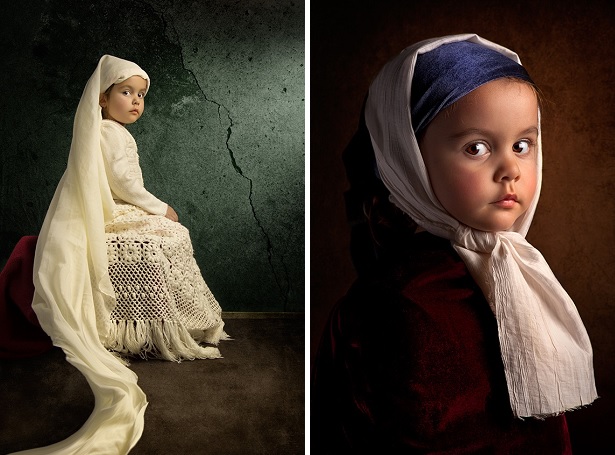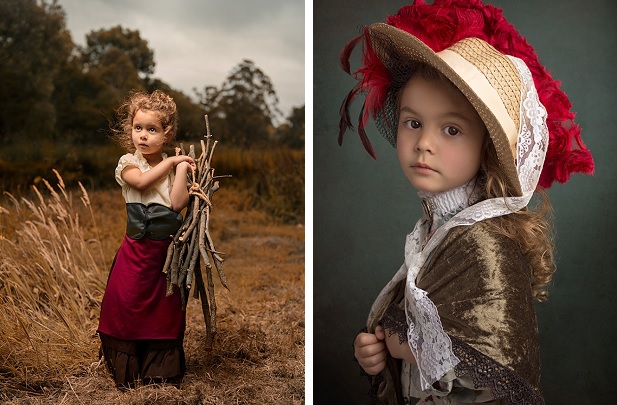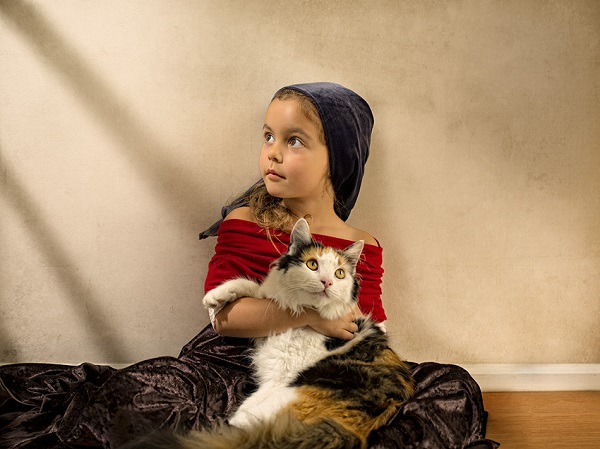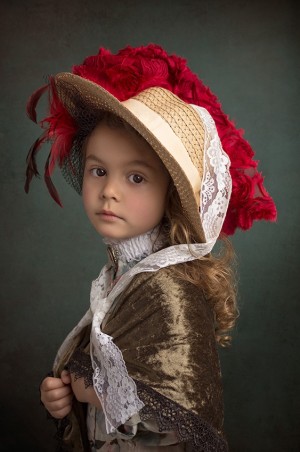Artist of the Week 3/6-3/12: Bill Gekas Captures Emotion within Storytelling Scenes of Children’s Portraiture
GALO: Speaking of light, several people believe that extra light sources produce a more powerful image. The Potatoes photo, of your Dutch-dressed daughter staring out a window while peeling potatoes in a kitchen, proves that a one-light setup makes for a dynamic photo. What are the advantages or disadvantages of one-light setups?
BG: Many scenarios require multiple light setups. I’ve been no stranger to them, for there will be times when a single artificial light source isn’t enough to do what I want. As great as it is to have this type of control in lighting with using more than one source, I prefer to use a single light in most cases because it mimics more closely the behavior of natural lighting. Despite using artificial strobes to light my scenes, the main aim when it comes to my lighting is to make it look like natural light instead of artificial light. At the same time, if I need more lights, I won’t hesitate in using them to get the envisioned shot.
The image Potatoes is a good example, where I had a single light source placed outside the window firing in, and further diffused by a white curtain producing a soft natural looking light. In this case, the natural light that was already there was great, but it needed to be stronger. In that, I could work at a faster shutter speed, and lower it so that the strobe solved these technical issues.
GALO: The series features sharp photos, emphasizing texture and your daughter’s emotive eyes. One in particular, Rapunzel, shows your daughter wearing a long head wrap cascading to the floor with a greenish, grainy background. Is the wall’s texture an example of “image noise,” adding more realism?
BG: In an age where many photographers are looking at clean crisp images, I’ve always preferred some organic component to them. Whether it is image or film noise from the camera, or in the case of my image Rapunzel, adding a texture to the wall to emphasize organic realism more than a clinical type of aesthetic would do. It’s much like the Japanese wabi-sabi aesthetic, which is centered on the acceptance of transience and imperfection, finding beauty in decay. In my images is a reflection of the imperfect world that surrounds us.

(L-R) Rapunzel and Girl without an earring (a rendition of Girl with a Pearl Earring by Dutch painter Johannes Vermeer) by photographer Bill Gekas. Photo Credit/Courtesy of: Bill Gekas.
GALO: Switching gears, several photos are recreations of famous and formative portraits, like The Girl with the Pearl Earring by Johannes Vermeer. What is your favorite recreation and why?
BG: My favorite image is a more recent one named Field Day. Although not a recreation of a particular painting, it is inspired by paintings many would have seen of a woman working in the fields. Like most of my other work, this is given my own twist and story based on how I envisioned the scene, and using colors and tones that fuse the work together.
This particular image is one of those rare ones that just came together better than I had originally envisioned. It was planned months beforehand, we shot outdoors, where some elements were out of my control such as the weather, temperature and type of light at the right time of day. Fortunately, it all came together for me; for that brief second when I clicked the shutter, I had a perfect amount of wind, which caught [my daughter’s] hair. It gave movement to the image. Sometimes, these little things can make all the difference that you never plan for.

(L-R) Field Day and Cameo by photographer Bill Gekas. Photo Credit/Courtesy of: Bill Gekas.
GALO: Out of curiosity, several photos show a cute cat with your daughter. Is the feline a family pet? What was it like photographing the cat since we know they love to move around a lot?
BG: The cat is a family pet, and like all cats, it won’t sit still for anything more than a minute or so. Fortunately, it is very attached to my daughter, so we have another minute or so up our sleeves to get the shot we need. When shooting with animals, it’s imperative to try and nail the shot within the first few frames. If unsuccessful, we try again a few minutes later. We’ve found the best time to photograph the cat in these shoots is when it’s in a lazy nap mode.

Feline friend by photographer Bill Gekas. Photo Credit/Courtesy of: Bill Gekas.
GALO: What requires more effort: capturing the intricacies of your daughter’s emotion, or the small details of the surrounding objects, and why?
BG: Definitely the emotion. The other small details are usually static, serving more as aesthetic and compositional support than anything else. Capturing the emotion for that split second is always part of the challenge, for it’s something you can’t force out of any subject. In a sitting where I am shooting maybe 40 or so frames, there will ever really be a few frames where that emotive expression is given. Then, it’s a matter of choosing the right final frame to work with there. No matter how perfect we have the composition, props, costumes, colors, lighting, etc., it’s the emotion that can make or break the image. This is the key that holds it all together; without it, we have nothing but impressive details.
GALO: Many photographers have weighed in on the camera versus human eye debate in terms of which one is more reliable and accurate when capturing an image. What are your thoughts?
BG: The camera can be a double edged sword despite the saying that the camera never lies; nothing could be further from the truth. The camera can lie, and usually does both in an artistic sense and a documentary one. It’s the person behind the lens that depicts if it should lie and to what extent. I’ve always believed humans are the more accurate ones; it’s like a video camera where the scene is rolling in front of us, giving us the true representation of what is occurring. On the other hand, the camera gives us a slice of time, which can be interpreted in many different ways. However, as artists we can use this medium deficiency to our advantage, giving the end viewer what we’d like them to see. This is a very powerful tool!

Plums by photographer Bill Gekas. Photo Credit/Courtesy of: Bill Gekas.


